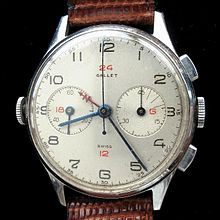- Direction Finding Watch
-
 Gallet MultiChron Navigator (1943) - wrist chronograph with 45 minute recording capability, crown-controlled synchronizable second hand, and direction finding 24 hour hand
Gallet MultiChron Navigator (1943) - wrist chronograph with 45 minute recording capability, crown-controlled synchronizable second hand, and direction finding 24 hour hand
The photo to the right shows a specialized 24-hour watch optimized for finding directions using the sun. With the watch set to indicate local time, the hour hand is pointed directly at the sun. South is indicated by the local noon position (in the northern hemisphere).
In the southern hemisphere, one must either use a left-handed watch (where the hands run counterclockwise), or the watch must be positioned so the sun is in the direction of the reflection of the hour hand against the dial's vertical (12-24) axis. Holding the watch upside down, while awkward, will achieve the same result. The noon position then indicates north, not south.
Technically, any 24-hour watch will do; there is nothing special about the direction-finding watch except that the 6 o'clock, 12 o'clock, 18 o'clock and 24 o'clock positions are labeled east, south, west and north, respectively.
Finding South With a 12-Hour Watch
The approximate south (or north, in the southern hemisphere) can be found fairly easily with any wrist watch or pocket watch with a 12-hour analog face.
In the northern hemisphere, the watch is held or laid flat so that the direction of the sun bisects the acute angle between the hour hand and 12 o'clock. For instance, at eight in the morning, the sun should be in the 10 o'clock position, and at two in the afternoon, it should be in the 1 o'clock position. The 12 o'clock position on the dial indicates south.
In the southern hemisphere, the watch is held or laid flat so that the direction of the sun bisects the reflex angle between the hour hand and 12 o'clock. For instance, at eight in the morning, the sun should be in the 4 o'clock position, and at two in the afternoon, it should be in the 7 o'clock position. The 12 o'clock position on the dial indicates north.
Accuracy
With both methods, the accuracy depends on a number of factors:
- Accurate determination of the position of the sun, which will vary with weather conditions and visual obstructions (landscape, buildings).
- Accurate positioning of the watch, which amongst other factors depends on the size of the dial, or rather the length of the hour hand, and the surface on which the watch is placed.
- In most parts of the world that observe Daylight saving time, the sun's position at noon will be offset by 15 degrees in the summer.
- The watch's accuracy relative to local solar time, which may differ significantly from local apparent time. For instance, the easternmost parts of Norway and the westernmost parts of Spain are both in the same time zone (Central European Time or Central European Summer Time, depending on the time of year), despite being nearly 45 degrees of longitude (three hours) apart, and China uses a single time zone across the country, which spans more than 60 degrees of longitude (four hours).
These factors can be mitigated to a certain extent by different means:
- Placing the watch on a perfectly horizontal surface and using the shadow of a plumb line to determine the direction of the sun will, to a great extent, mitigate the first two factors.
- The watch can easily be adjusted to compensate for daylight saving time.
- If the approximate longitude is known, it can also (somewhat less easily) be set to the approximate local mean time.
- Setting the watch to local apparent time, however, requires more advanced computations involving the equation of time.
The angular diameter of the sun is so small (approximately 30 arcminutes) that it makes no difference unless all other sources of inaccuracy are eliminated. The visual angle of the plumb line, if one is used, is likely to be larger.
See also
Categories:- Navigational equipment
- Watches
Wikimedia Foundation. 2010.

